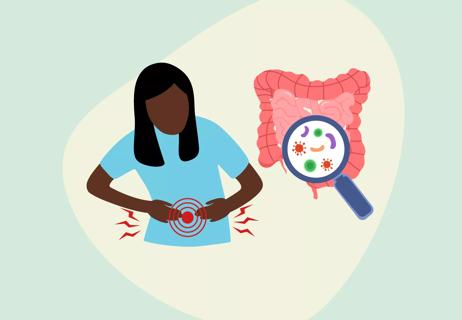Learn about the symptoms and find out how to protect yourself and your family

Once believed to be a great innovation, lead paint has turned out to be a huge problem.
Advertisement
Cleveland Clinic is a non-profit academic medical center. Advertising on our site helps support our mission. We do not endorse non-Cleveland Clinic products or services. Policy
Lead paint has existed since as early as the fourth century B.C., and it’s been causing health problems ever since. And while the dangers of lead paint have echoed throughout history, we’re still feeling the effects today. Pediatrician Roopa Thakur, MD, FAAP, explains how lead poisoning can affect our health and shares what we can do to protect our loved ones from it.
Certain lead compounds were added to paint to create bright, vivid colors like white, yellow and red. And since lead is richly pigmented, lead paint could go a long way when covering large areas. Lead also makes paint resistant to moisture and helps it dry faster. Overall, since lead paint was marketed as being more durable, it was widely used in buildings or to coat metals and children’s toys.
By the 1920s, the dangers of lead paint were fairly obvious in this country. Children who accidentally ate lead paint chips or inhaled lead paint dust started experiencing physical and neurological issues that lined up with the symptoms of lead poisoning. And between 1925 and 1927, more painters died in the United States than any other working group. Efforts were made to ban it, but nothing stuck until 1971 when Congress passed the first federal regulation for lead-based paint. Seven years later, U.S. Consumer Product Safety Commission issued a final ban on the use of lead paint in all residential housing.
Advertisement
Lead can be swallowed, inhaled or absorbed through your skin. However, your body takes in more of it when lead is inhaled. When it enters your body, lead is stored in your bones, blood and tissue. As you age, your bones demineralize and lead is released back into your body.
For an adult, a small amount of lead in your body is not a huge concern. A low range of lead in an adult’s system would be less than 10 micrograms per deciliter (mcg/dL). If you’re pregnant, a level of five mcg/dL would be considered elevated because even the smallest amounts of lead in your system could cause problems with fetal development.
A lead blood level above 10 mcg/dL up to 25 mcg/dL is an indicator of regular lead exposure. Medical treatment is usually required once a person hits 80 mcg/dL or if they’re at a lower level but experiencing symptoms of lead poisoning.
For a child, even the smallest amount of lead can cause developmental problems. With kids, 3.5 mcg/dL of lead in their blood is considered higher than most children’s levels.
High levels of lead in your bloodstream can cause serious health conditions. Some of them include:
Lead poisoning can affect your reproductive system in several ways. For those who were born male, lead exposure could affect the libido and semen quality. This could lead to fertility issues, miscarriages, preterm birth and more for a partner. For those who were born female, lead exposure can alter menstrual cycles, reduce fertility potential, delay conception time and interrupt hormone production.
Long-term exposure to lead can slow or stop the production of hemoglobin. Hemoglobin is what gives red blood cells their color and helps blood carry oxygen throughout your body. When lead is in your system, it can keep your body from getting enough iron, and this can lead to anemia.
According to the National Kidney Foundation, kidney damage from lead exposure isn’t as common in the United States these days. If it does occur, cases are usually among workers who are exposed to high amounts of lead on the job after several years of exposure and in those with pre-existing kidney problems. Low levels of lead from drinking water or house paint don’t tend to cause kidney damage.
If you do have kidney damage, it might not be obvious, as most people don’t experience symptoms. However, the damage could show up in the form of extra protein in your urine, high blood pressure or an increased risk for gout. If you think something is wrong, talk to your healthcare provider so they can test for lead.
Lead poisoning can take a major toll on your brain. If it damages your prefrontal cerebral cortex (the part that processes information), hippocampus (the part of your brain that handles learning and memory) and cerebellum (the part that helps control your body’s movements), the damage could lead to behavioral problems, nerve damage and possibly Alzheimer’s disease, Parkinson’s disease or even schizophrenia.
Advertisement
Other symptoms of lead poisoning include:
While it can affect people of all ages, lead poisoning hits children the hardest. Its health effects are more severe for kids under the age of six because their bodies are developing and growing fast. This age group also tends to be at a higher risk for lead poisoning because young children often put their hands and other objects in their mouths.
“Children can be exposed to lead at home, school, daycare or even grandma’s house. Lead particles can come from paint chips or paint dust. If those particles are ingested and they get into the bloodstream, that can cause long-term problems for a child,” says Dr. Thakur.
Some of those problems include:
Dr. Thakur says that a child could be living with lead poisoning and not show any signs. On the other hand, if they’re experiencing symptoms, those symptoms might not be linked to lead poisoning.
“When a small child’s lead levels are high, you may not see anything at that moment. Other times, a child might experience vague symptoms like trouble sleeping, behavior problems or feeling tired. As time goes on, you may see long-term effects like stomach problems or behavior issues,” Dr. Thakur says.
Advertisement
She adds that if lead levels are extremely high, a child might have seizures or struggle to do well at school. Their IQ might drop as well.
One thing you can do — talk to your child’s pediatrician if you suspect something is wrong.
Dr. Thakur emphasizes that it’s important to limit lead exposure early in life because, with proper management, lead poisoning is preventable. Healthcare providers start talking about lead poisoning prevention with families when their child is in infancy. This is because infants and toddlers are playing on the floor, where lead paint dust tends to settle, and as noted, engaging in hand-to-mouth behavior that can result in lead dust inhalation and ingestion.
“I like to share information with parents about limiting lead exposure during a child’s six-month visit. We’ll talk about the best ways to clean the home. If a parent has an occupation that might expose them to lead, I’ll advise them on how to clean their clothes and shoes,” says Dr. Thakur.
At a child’s 12-month and 24-month visits, Dr. Thakur will do a formal assessment using a questionnaire. If a child is considered high-risk based on this questionnaire, she’ll take a blood sample. For older children who have risk factors for ongoing lead exposure, she recommends yearly blood tests until the age of 6 years.
Advertisement
But again, keeping kids safe starts with maintaining a clean home.
Dr. Thakur recommends wet mopping daily to remove any lead particles from paint chips or dust. She says that some local health departments even allow families to borrow HEPA vacuums at no cost. These vacuums provide a much deeper clean than average vacuums.
She suggests wiping down anything that’s on the floor, too. This includes the bases of floor lamps and the legs of tables and chairs. Also, taking your shoes off before entering your home can help, especially if you’re exposed to lead on the job or live in an area with lead-contaminated soil.
While the effects of lead poisoning cannot be reversed, the quality of life for those affected can be improved with a few simple measures.
To prevent further exposure, the lead source first needs to be professionally removed from your home. Never try to do this yourself. If you’re not sure where to start, contact your local health department.
“If a lead blood level is above 45 mcg/dL, your provider may recommend chelation therapy to quickly reduce it. This can require hospital admission. If we know that a child has ingested lead paint chips, we can do a bowel cleanout to prevent further lead absorption in their GI tract,” Dr. Thakur adds.
Chelation therapy is when certain medications are used to bind lead in your blood. This therapy is delivered through an IV or pills. Once it takes effect, the lead comes out of your body when you urinate.
If you believe something is wrong, talk to your healthcare provider.
The main thing to keep in mind: If you think that you or your child might have been exposed to lead, talk to your healthcare provider right away to prevent long-term effects.
“We can’t tell what the outcomes are going to be based on lead levels. The only thing we can do is prevent lead exposure to begin with. There is no safe lead level. That’s why getting tested is very important,” says Dr. Thakur.
Learn more about our editorial process.
Advertisement

Rinsing raw chicken raises the risk of spreading harmful bacteria and causing foodborne illness

Keep cooked rice and pasta in your fridge — not on your counter — to help prevent this sneaky food poisoning

Mushroom poisoning is real — and it can cause liver failure

Food poisoning typically passes within 12 to 48 hours, with symptoms including diarrhea, nausea, stomach pain and vomiting

Cleanliness and food preparation precautions are the best defense against infection

Children should be screened for lead poisoning starting at ages 1 and 2

A dermatologist’s advice for finding some relief for that itchy rash

How to protect yourself from food poisoning

If you’re feeling short of breath, sleep can be tough — propping yourself up or sleeping on your side may help

If you fear the unknown or find yourself needing reassurance often, you may identify with this attachment style

If you’re looking to boost your gut health, it’s better to get fiber from whole foods